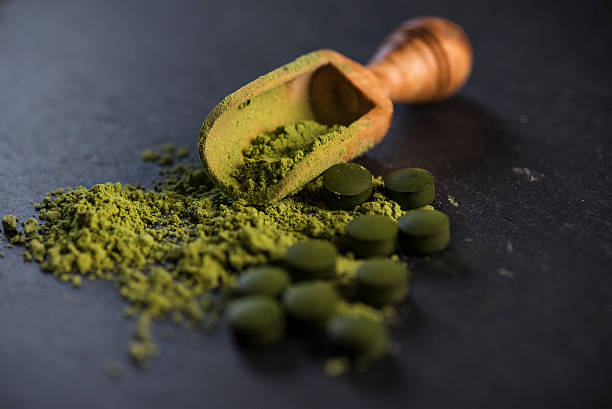Alternative Treatments, Supplements and Herbs
Liquid Chlorophyll vs. Other Forms of Chlorophyll
In the world of chlorophyll, liquid chlorophyll is often compared to other forms of chlorophyll for its potential health benefits. But what sets liquid chlorophyll apart from its counterparts? In this article, we will explore the differences between liquid chlorophyll and other forms of chlorophyll to help you make an informed decision.
Liquid chlorophyll, as the name suggests, is a liquid form of chlorophyll that is easily absorbed by the body. It is derived from green plants and is known for its vibrant green color. Some proponents claim that liquid chlorophyll offers a wide range of health benefits, including detoxification, improved digestion, and increased energy levels.
On the other hand, other forms of chlorophyll, such as chlorophyll tablets or powders, may have different properties and absorption rates. It is important to understand the unique characteristics of each form of chlorophyll to determine which one may suit your needs best.
Join us as we delve into the world of liquid chlorophyll and explore its potential benefits compared to other forms of chlorophyll.

What is Liquid Chlorophyll?
Liquid chlorophyll, as mentioned earlier, is a liquid form of chlorophyll that is derived from green plants. It is packed with nutrients and antioxidants that are believed to provide various health benefits. Liquid chlorophyll is often extracted from plants like alfalfa, wheatgrass, and spirulina.
One of the key advantages of liquid chlorophyll is its high bioavailability. Due to its liquid form, it can be easily absorbed by the body, allowing for quick and efficient utilization of its beneficial compounds. This makes liquid chlorophyll an attractive option for those looking for fast results.
Liquid chlorophyll is also known for its detoxifying properties. It is believed to help eliminate toxins from the body, support liver function, and promote overall detoxification. Additionally, liquid chlorophyll may help improve digestion by promoting the growth of beneficial gut bacteria and easing digestive discomfort.
Benefits of Liquid Chlorophyll
Liquid chlorophyll is often touted for its potential health benefits. While scientific research on liquid chlorophyll is limited, many users have reported positive effects. Here are some potential benefits associated with liquid chlorophyll:
1. Detoxification
Liquid chlorophyll is believed to aid in detoxification by binding to toxins and facilitating their elimination from the body. It may help cleanse the liver, kidneys, and blood, promoting overall detoxification and supporting the body’s natural detox processes.
2. Improved digestion
Liquid chlorophyll has been linked to improved digestion. It may help reduce digestive issues like bloating, gas, and constipation. By promoting the growth of beneficial gut bacteria, liquid chlorophyll can support a healthy digestive system.
3. Increased energy levels
Some users claim that liquid chlorophyll can boost energy levels and combat fatigue. It is believed to enhance oxygen transport in the body, which can improve energy production and reduce feelings of tiredness.
4. Antioxidant properties
Liquid chlorophyll is rich in antioxidants, which help protect the body against oxidative stress and damage caused by free radicals. Antioxidants can support overall health and may have anti-aging effects.
5. Skin health
Liquid chlorophyll is often used for its potential benefits on skin health. It may help improve the appearance of acne, promote wound healing, and reduce skin inflammation.

Comparison of Liquid Chlorophyll With Other Forms of Chlorophyll
When comparing liquid chlorophyll with other forms of chlorophyll, it is important to consider factors such as absorption, convenience, and personal preference. Here, we will explore how liquid chlorophyll fares against chlorophyll tablets and powders.
Absorption and bioavailability
Liquid chlorophyll, due to its liquid form, is easily absorbed by the body. This allows for quick utilization of its beneficial compounds. Chlorophyll tablets and powders, on the other hand, may take longer to break down and be absorbed, potentially reducing their bioavailability.
Convenience
Liquid chlorophyll offers convenience in terms of dosage and ease of use. It can be easily added to water or other beverages, making it a hassle-free option for daily supplementation. Chlorophyll tablets and powders may require precise measurements or additional steps for consumption.
Personal preference
Choosing between liquid chlorophyll, tablets, or powders ultimately comes down to personal preference. Some individuals may prefer the taste and convenience of liquid chlorophyll, while others may find tablets or powders more suitable for their lifestyle.
Absorption and Bioavailability of Liquid Chlorophyll
Liquid chlorophyll is known for its high absorption rate and bioavailability. When consumed, it is quickly absorbed by the body, allowing for efficient utilization of its beneficial compounds. This is due to its liquid form, which enables easier digestion and absorption compared to solid forms like tablets or powders.
The high bioavailability of liquid chlorophyll means that the body can readily access its nutrients and antioxidants. This is particularly important for individuals looking for fast results or those with compromised digestive systems. Liquid chlorophyll offers a convenient option for those who want to maximize the absorption of chlorophyll’s health-promoting properties.

Potential Side Effects and Precautions of Liquid Chlorophyll
While liquid chlorophyll is generally considered safe for consumption, it is important to be aware of potential side effects and take necessary precautions. Here are some considerations to keep in mind:
1. Allergies
Individuals with known allergies to certain plants, such as alfalfa or wheatgrass, should exercise caution when using liquid chlorophyll derived from these sources. Allergic reactions can range from mild symptoms like itching or hives to more severe reactions like difficulty breathing. It is advisable to consult a healthcare professional before starting any new supplement.
2. Stool discoloration
Liquid chlorophyll can cause temporary changes in stool color, turning it green or black. This is a normal and harmless side effect. However, if you notice persistent or concerning changes in stool color, it is recommended to seek medical advice.
3. Interactions with medications
Liquid chlorophyll may interact with certain medications, such as blood thinners or medications for cancer treatment. If you are taking any medications, it is important to consult your healthcare provider before incorporating liquid chlorophyll into your routine.

How To Use Liquid Chlorophyll
Using liquid chlorophyll is relatively simple and convenient. Here are some tips on how to incorporate it into your daily routine:
1. Follow the recommended dosage
Always follow the recommended dosage provided by the manufacturer or your healthcare professional. Liquid chlorophyll is usually consumed in small amounts, typically diluted in water or juice.
2. Start with a lower dosage
If you are new to liquid chlorophyll, it is advisable to start with a lower dosage and gradually increase it as your body adjusts. This will help minimize any potential digestive discomfort or side effects.
3. Mix with water or other beverages
Liquid chlorophyll can be mixed with water or your favorite beverage of choice. This allows for easy consumption and helps mask any strong taste that may be present.
4. Incorporate into your daily routine
To experience the potential benefits of liquid chlorophyll, it is important to incorporate it into your daily routine consistently. Consider taking it at a specific time each day to establish a routine.

Other Forms of Chlorophyll and Their Uses
Apart from liquid chlorophyll, there are other forms of chlorophyll available in the market, each with its unique uses and benefits. Here are some common forms of chlorophyll:
1. Chlorophyll Tablets
Chlorophyll tablets are a convenient option for those who prefer a solid form of chlorophyll. They can be easily taken on the go and offer precise dosage control. Chlorophyll tablets are commonly used for their potential detoxification and antioxidant properties.
2. Chlorophyll Powders
Chlorophyll powders are versatile and customizable. They can be mixed with water, smoothies, or other beverages for easy consumption. Chlorophyll powders are often used for their potential benefits on digestion, skin health, and overall well-being.
Conclusion
Its quick absorption, potential health advantages, and brilliant green hue make liquid chlorophyll stand out. Those seeking the potential benefits of chlorophyll supplements may find liquid chlorophyll more practical and efficient than tablets or powders.
To verify liquid chlorophyll or any other chlorophyll is safe and suitable for your needs, see a healthcare practitioner before using it. Follow the correct dosage and take care to maximize chlorophyll’s advantages and minimize its hazards.


